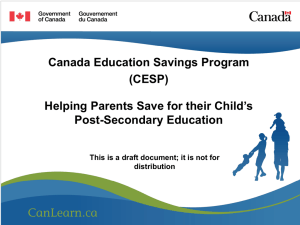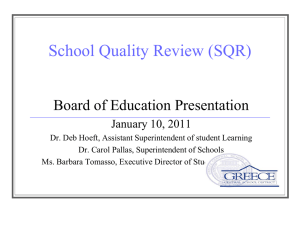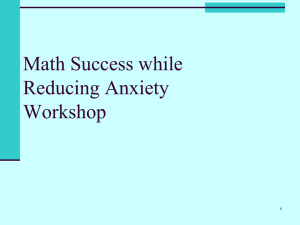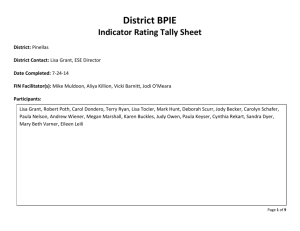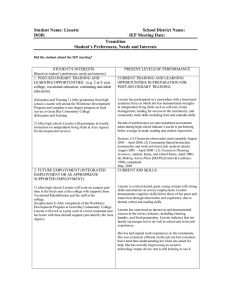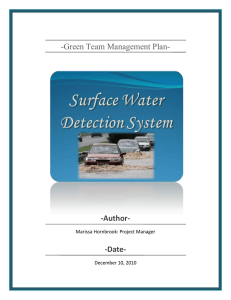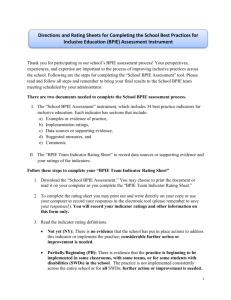Acheiving Positive PSE Outcomes
advertisement
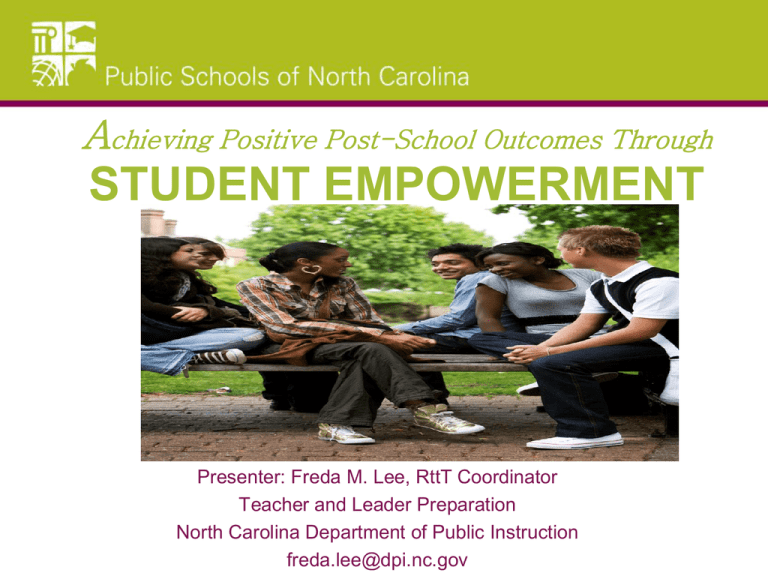
Achieving Positive Post-School Outcomes Through STUDENT EMPOWERMENT Presenter: Freda M. Lee, RttT Coordinator Teacher and Leader Preparation North Carolina Department of Public Instruction freda.lee@dpi.nc.gov Activity Describe to your neighbor a transition time in life. – How did you feel? – Did you feel empowered at the time? – Were you prepared for the change? – Did you have support from anyone? – How did you cope with the change? Empowered Transition Process • Embraces risk and possible failure • Provides support and scaffolding as needed • Includes formal and informal transition assessment • Is ongoing, nimble and flexible • Includes adult services Student Empowerment • Begins at birth • Inclusive • Not easy • Looks different for everyone!!! Empowered Transition Process is: • Student Driven • Collaborative • Futures Oriented • Involves Backward Planning Why is Self-Determination Important for Students with Disabilities? • Helps to shatter pervasive stereotypes • Increases employment options • Student self-selection of future goals is critical for success in all domains of life: – Independent living – Employment – Community integration – Personal relationships Transition Assessments can include: • Interest Inventories • Dream Sheets • Informal pencil and paper assessments • Interviews • Situational and/or CommunityBased Assessments • Role-Playing • Observations • Formal Placement/Screening Tests • Formal/Standardized Transition Assessments Live, Work and Play Balanced Planning – – – – – – – Home School Social Employment Church Community Involvement Recreation Three Stages of Career Planning Self Exploration (Birth- 8th Grade) Career Exploration (9th-12th Grades) Career Planning and Management (Ages 18+) Youthhood.org • The Youthhood Web site is a dynamic, curriculumbased tool that can help young adults plan for life after high school. Although the site addresses youth directly, it is intended to be used as a curriculum within a classroom, community program, or in any setting where adults are working with youth to set goals and plan for the future. The Youthhood includes informational content, interactive activities, an online magazine, and a wealth of other opportunities for youth to connect what's important to them to their learning experiences. Youthhood Site includes: • • • • • • • Private Journal: An online journal allows youth to write down their thoughts, ideas, issues, or anything else as they work their way through the Web site. This journal is completely private, with access only to the student through use of their password. Activities Folder: Each content area has corresponding activities to reinforce what youth learn. These can be saved to an Activity Folder for viewing, editing, or printing at a later date. Life Map: The Life Map is a tool to help youth plan for the future. Youth can write down goals, steps to achieve goals, and other important information related to what they’re learning on the Web site. Teachers can also use this for assignments. For youth with disabilities, the Life Map parallels the Individualized Education Program and can be used transition planning meeting preparation by young adults. Class Notebook: Each content area has a corresponding Class Notebook for youth to reflect on the material they just read. Instructors can give youth an assignment to write in their Notebook about what they learned on a certain topic. Instructors can also read and comment on the student’s work in the notebook. Links to Web Sites: Each content area has corresponding Web sites where youth can go to learn more about specific topics. Sites are arranged to correspond with the content sections of the Web site. Youthhood Poll: Monthly poll questions relevant to different areas of transition allow youth to reflect on their answers, submit comments, view poll results, and read comments from youth around the world (currently under construction. Under the Hood e-Zine: Youthhood’s online magazine, Under the Hood, is written by young adults to share what youth are thinking, saying, and experiencing across the U.S. and around the world (currently under construction). TRANSITION ADVANCES • • • • • • PAST Students Isolated Watered Down Curriculum for SWDs Attendance Certificate Bound Technology Limited and Very Expensive Few Opportunities for CBT PSE Opportunities Rare • • • • • • NOW Students More Integrated Increased Rigor for SWDs Diploma and Graduation Certificate Technology More Abundant and Less Expensive More Opportunities for CBT PSE More Accessible CHALLENGES CONTINUE • Accountability measures that do not always accommodate SWDs and their needs (4 year graduation rate, etc.). • Parents/caregivers who are “over protective” or “unrealistic” • Failure to have “high expectations” for all SWDs • Society that continues to stereotype SWDs • Lack of ongoing interagency collaboration • Limited number of PSE options Promising Transition Practices= • Early Intervention • Student Empowerment • Direct Instruction and Academic Support • Extensive Use of Technology • Comprehensive Transition Assessment and Planning • IHE Partnerships • Interagency Collaboration • Post-Secondary Education Programs (PSE) NSTTAC Case Study • Read and think about Lissette’s case study • Discuss with your partner • Determine the following: – Does it appear that Lissette has participated in transition assessment of any type and/or CBT? – Do we need additional information? If so, what information is needed and how might we get it? – Do you think Lissette is an empowered student? If so, what evidence is there of her demonstrating self-determination or empowerment? Select Transition Web Resources National Secondary Transition Technical Assistance Center NSTTAC.org Post-Secondary Outcomes Center- www.psocenter.org Division of Career Development &Transition dcdt.org North Carolina Division of Career Development &Transition ncdcdt.org College & Career Readiness Center ccrscenter.org Exceptional Children Assistance Center- ecac.org Think College thinkcollege.net North Carolina Post-Secondary Alliance cidd.unc.edu Post-Secondary Education Research Center www.trasitiontocollege.net College Fund of North Carolina (CFNC-Gear Up) www.cfnc.org Zarrow Center http://education.ou.edu/zarrow/ U.S. Dept. of Labor O*NET www.onecenter.org University of Kansas transitioncoalition.org Cradle to College Collection ideapartnership.org Select Transition Resources • Assess for Success –Sitlington, Nuebert, Begun, Lombard, and Leconte. Publisher: Corwin Press • Transition Methods for Youth With Disabilities-Aspel, Everson and Test. Publisher: Pearson, Merrill and Prentice Hall • Teaching Self-Determination-Field, Martin, Miller, Ward and Wehmeyer. Publisher: Council for Exceptional Children • Life Centered Career Education (LCCE)- Donn Brolin. Publisher: Council for Exceptional Children • Life Beyond the Classroom- Paul Wehman. Publisher: Brookes Publishing
